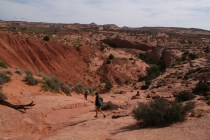Pahranagat National Wildlife Refuge, just south of the ranching community of Alamo, encompasses 5,382 acres of lakes, marshes, meadows, riparian areas and open desert. The three largest bodies of water in the refuge are Upper Lake, Middle Pond and Lower Lake, fed by thermal springs.
- Home
- >> Local
- >> Local Columns
Deborah Wall

Deborah Wall is the author of "Great Hikes, a Cerca Country Guide," and "Basecamp Las Vegas: Hiking the Southwestern States," published by Stephens Press. Email: deborabus@aol.com
Longtime Southern Nevadans who love the Mojave Desert nevertheless often develop a desire to explore other arid landscapes. Typically, they dream of the Sonoran Desert, whose scenery may have inspired them to live in the Southwest. An excellent place to fulfill that desire is in and around Tucson, Ariz. There are dozens of places to take in the flora and fauna, but two places stand out: Saguaro National Park and the Arizona-Sonora Desert Museum, which has one of the world’s best zoos.
The monsoon season is over, the crowds have gone, and the daytime temperatures are ideal — perfect conditions for a fall trip to Lake Powell. The lake, which boasts more than 1,800 miles of shoreline, lies within the Glen Canyon National Recreation Area, on the border of Arizona and Utah. The lake was created when the Glen Canyon Dam was built. Although the dam was, and still is, a controversial topic for many, the lake it created has become an outdoor person’s paradise.
The Great Gallery in Horseshoe Canyon is one of the most significant rock art sites in North America. It is in a remote area of Canyonlands National Park, Utah. A trip there requires plenty of preparation, plus the equipment and willingness to drive a 30-mile gravel road to the trailhead. Once there, you’ll need to hike down through the slick rock, which contains a few high drop-offs into the canyon. It is a moderately strenuous hike of about 6.5 miles roundtrip with an elevation loss/gain of about 800 feet at the beginning and that much to climb back up at hike’s end.
Editor’s note: Be sure to check road conditions before traveling.
With the opening of school and the approach of holidays, most of us become too busy to escape for long from our city lives. That makes the Ash Meadows National Wildlife Refuge a good choice for a September escape. Lying in Nevada near the California state line, it’s close enough to enjoy thoroughly in a single day, yet it’s a little farther north, a little higher, and therefore a little cooler, than our own valley. Now is an especially good time to go if you enjoy birdwatching or counting how many different kinds you can see, for the fall migratory season is upon us, and more than 275 species have been recorded there.
Grand Canyon National Park is visited by nearly 5 million people a year, and not surprisingly, many complain that it’s crowded. But you don’t have to endure that because the vast majority of those millions gaze upon the canyon from its South Rim. Those who choose the North Rim get much more elbow room.
A visit to Canyon de Chelly National Monument is a feast for the eyes and soul. There, you will find sheer red sandstone cliffs rising 1,000 feet above the fertile farmland of the canyons, where prehistoric Ancestral Puebloan ruins and hundreds of other archaeological sites dot the landscape. People have lived there nearly 5,000 years; it is believed to be the longest continuous occupancy of any site on the Colorado Plateau.
Nevada is home to 23 state parks, the majority with only one unique feature. But Berlin-Ichthyosaur State Park is in a class of its own, as it features not only a well-preserved historic mining town but also remains of the ancient ichthyosaur (pronounced ICK-thee-o-saur), our state fossil.
Cedar Breaks National Monument in southern Utah is a small park most cherished by us desert dwellers for its cool summer temperatures and spectacular views into its deep, hoodoo-filled amphitheater. During July and August, you’ll find the little park brimming with additional activities, any one of which, by itself, might be worth the journey there.
Before the weather gets any hotter in our region, a good place for a short hike might be Mojave National Preserve in California just south of the Nevada border. One you might try is the Rock Spring Loop, which boasts a historic stone house, the site of a 19th-century Army post, a natural spring and American Indian petroglyphs.
You could spend years exploring the 1.9 million-acre Grand Staircase-Escalante National Parkcq in Utah, yet barely shorten the list of wonders still to see there.
Along the Sedona-Oak Creek Canyon Scenic Drive just north of Sedona, you’ll find Slide Rock State Park, one of Arizona’s most beloved destinations.
By most definitions, giant sequoias are the largest trees on Earth, and they will surely inspire awe in anyone fortunate enough to see them. And because they grow within a long weekend’s journey of Southern Nevada, you can be among the fortunate. But if you intend to do that this summer, it’s best to plan now, for this kind of trip will be most pleasant if you make reservations, allowing time to incorporate other activities.
Ask any local nature lover if he has visited the Bowl of Fire, and the answer will usually be, “Of course!” But many of those answers are incorrect because people confuse it with the similarly named Valley of Fire State Park. While both are must-sees for anyone who can do both and involve similar terrain, the Bowl of Fire is a completely different experience because it is accessible only by hiking. That means on most days, you’ll likely have the place to yourself. And you’ll always have the satisfaction of knowing you got there on your own two feet and will power.






















